Question #241
A company is developing a solution that allows smart refrigerators to send temperature information to a central location.
The solution must receive and store messages until they can be processed. You create an Azure Service Bus instance by providing a name, pricing tier, subscription, resource group, and location.
You need to complete the configuration.
Which Azure CLI or PowerShell command should you run?
A.

B.

C.

D.

The solution must receive and store messages until they can be processed. You create an Azure Service Bus instance by providing a name, pricing tier, subscription, resource group, and location.
You need to complete the configuration.
Which Azure CLI or PowerShell command should you run?
A.

B.

C.

D.

Question #242
HOTSPOT -
You are developing an application that uses Azure Storage Queues.
You have the following code:
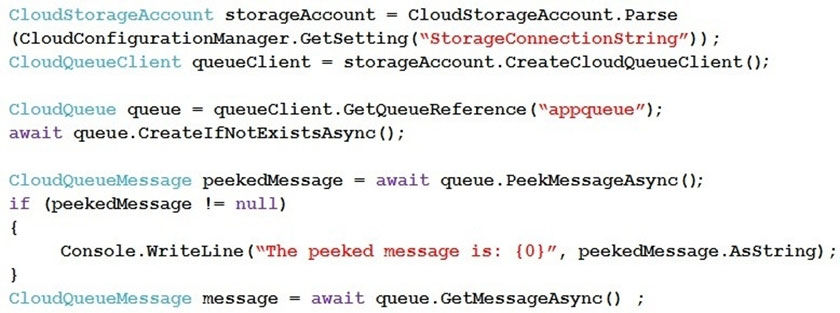
For each of the following statements, select Yes if the statement is true. Otherwise, select No.
NOTE: Each correct selection is worth one point.
Hot Area:
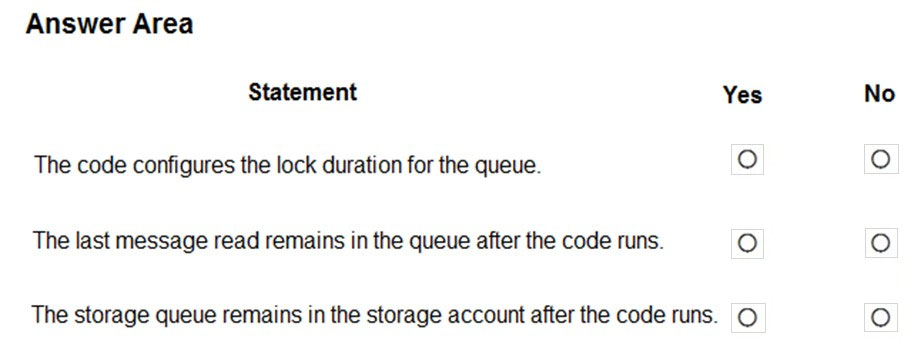
You are developing an application that uses Azure Storage Queues.
You have the following code:

For each of the following statements, select Yes if the statement is true. Otherwise, select No.
NOTE: Each correct selection is worth one point.
Hot Area:

Question #243
A company is developing a solution that allows smart refrigerators to send temperature information to a central location.
The solution must receive and store messages until they can be processed. You create an Azure Service Bus instance by providing a name, pricing tier, subscription, resource group, and location.
You need to complete the configuration.
Which Azure CLI or PowerShell command should you run?
A.

B.

C.

D.

The solution must receive and store messages until they can be processed. You create an Azure Service Bus instance by providing a name, pricing tier, subscription, resource group, and location.
You need to complete the configuration.
Which Azure CLI or PowerShell command should you run?
A.

B.

C.

D.

Question #244
Note: This question is part of a series of questions that present the same scenario. Each question in the series contains a unique solution that might meet the stated goals. Some question sets might have more than one correct solution, while others might not have a correct solution.
After you answer a question in this section, you will NOT be able to return to it. As a result, these questions will not appear in the review screen.
You are developing an Azure Service application that processes queue data when it receives a message from a mobile application. Messages may not be sent to the service consistently.
You have the following requirements:
✑ Queue size must not grow larger than 80 gigabytes (GB).
✑ Use first-in-first-out (FIFO) ordering of messages.
✑ Minimize Azure costs.
You need to implement the messaging solution.
Solution: Use the .Net API to add a message to an Azure Storage Queue from the mobile application. Create an Azure Function App that uses an Azure Storage
Queue trigger.
Does the solution meet the goal?
After you answer a question in this section, you will NOT be able to return to it. As a result, these questions will not appear in the review screen.
You are developing an Azure Service application that processes queue data when it receives a message from a mobile application. Messages may not be sent to the service consistently.
You have the following requirements:
✑ Queue size must not grow larger than 80 gigabytes (GB).
✑ Use first-in-first-out (FIFO) ordering of messages.
✑ Minimize Azure costs.
You need to implement the messaging solution.
Solution: Use the .Net API to add a message to an Azure Storage Queue from the mobile application. Create an Azure Function App that uses an Azure Storage
Queue trigger.
Does the solution meet the goal?
Question #245
DRAG DROP -
You develop software solutions for a mobile delivery service. You are developing a mobile app that users can use to order from a restaurant in their area. The app uses the following workflow:
1. A driver selects the restaurants for which they will deliver orders.
2. Orders are sent to all available drivers in an area.
3. Only orders for the selected restaurants will appear for the driver.
4. The first driver to accept an order removes it from the list of available orders.
You need to implement an Azure Service Bus solution.
Which three actions should you perform in sequence? To answer, move the appropriate actions from the list of actions to the answer area and arrange them in the correct order.
Select and Place:
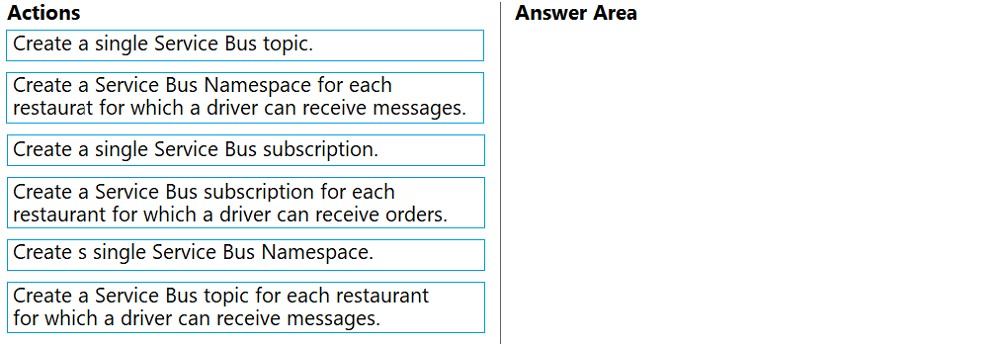
You develop software solutions for a mobile delivery service. You are developing a mobile app that users can use to order from a restaurant in their area. The app uses the following workflow:
1. A driver selects the restaurants for which they will deliver orders.
2. Orders are sent to all available drivers in an area.
3. Only orders for the selected restaurants will appear for the driver.
4. The first driver to accept an order removes it from the list of available orders.
You need to implement an Azure Service Bus solution.
Which three actions should you perform in sequence? To answer, move the appropriate actions from the list of actions to the answer area and arrange them in the correct order.
Select and Place:

Question #246
HOTSPOT -
You develop a news and blog content app for Windows devices.
A notification must arrive on a user's device when there is a new article available for them to view.
You need to implement push notifications.
How should you complete the code segment? To answer, select the appropriate options in the answer area.
NOTE: Each correct selection is worth one point.
Hot Area:
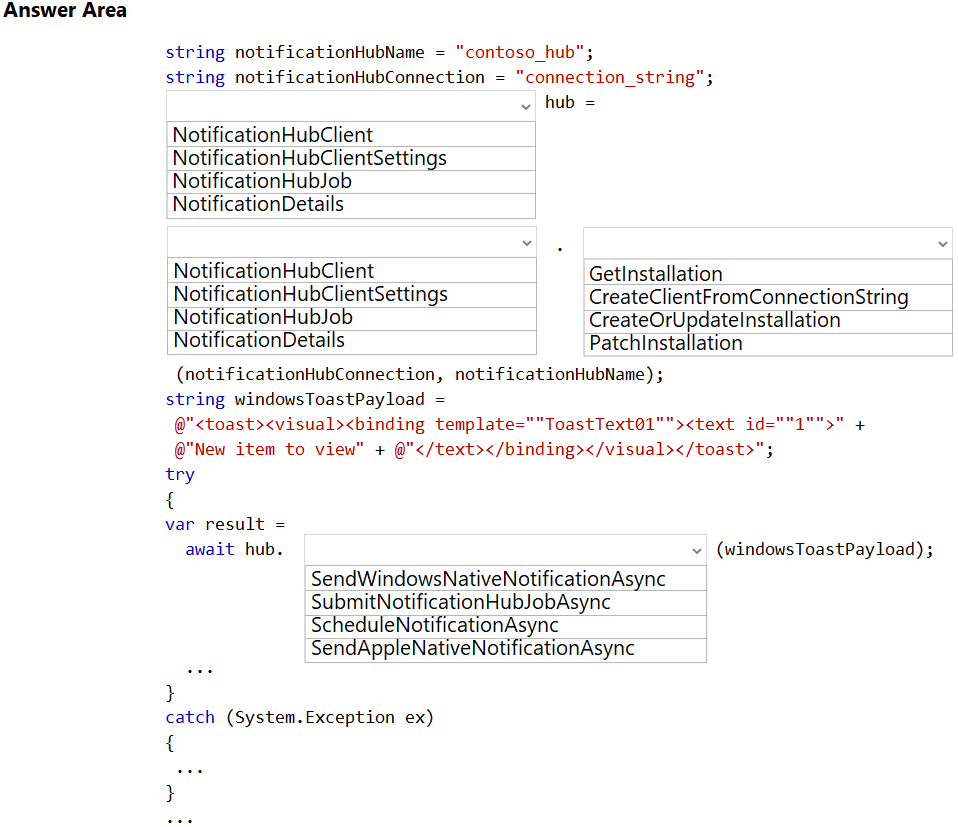
You develop a news and blog content app for Windows devices.
A notification must arrive on a user's device when there is a new article available for them to view.
You need to implement push notifications.
How should you complete the code segment? To answer, select the appropriate options in the answer area.
NOTE: Each correct selection is worth one point.
Hot Area:

Question #247
You are developing an Azure messaging solution.
You need to ensure that the solution meets the following requirements:
✑ Provide transactional support.
✑ Provide duplicate detection.
✑ Store the messages for an unlimited period of time.
Which two technologies will meet the requirements? Each correct answer presents a complete solution.
NOTE: Each correct selection is worth one point.
You need to ensure that the solution meets the following requirements:
✑ Provide transactional support.
✑ Provide duplicate detection.
✑ Store the messages for an unlimited period of time.
Which two technologies will meet the requirements? Each correct answer presents a complete solution.
NOTE: Each correct selection is worth one point.
Question #248
DRAG DROP -
You develop a gateway solution for a public facing news API.
The news API back end is implemented as a RESTful service and hosted in an Azure App Service instance.
You need to configure back-end authentication for the API Management service instance.
Which target and gateway credential type should you use? To answer, drag the appropriate values to the correct parameters. Each value may be used once, more than once, or not at all. You may need to drag the split bar between panes or scroll to view content.
NOTE: Each correct selection is worth one point.
Select and Place:
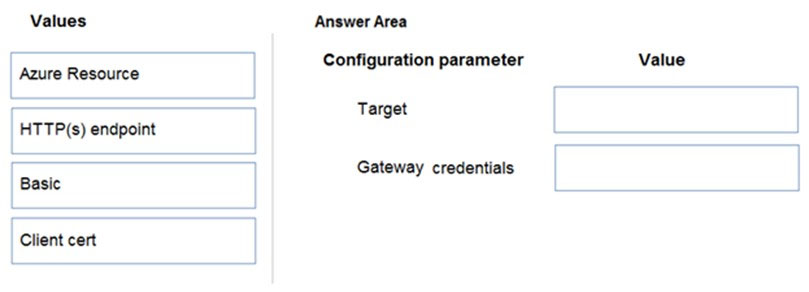
You develop a gateway solution for a public facing news API.
The news API back end is implemented as a RESTful service and hosted in an Azure App Service instance.
You need to configure back-end authentication for the API Management service instance.
Which target and gateway credential type should you use? To answer, drag the appropriate values to the correct parameters. Each value may be used once, more than once, or not at all. You may need to drag the split bar between panes or scroll to view content.
NOTE: Each correct selection is worth one point.
Select and Place:

Question #249
HOTSPOT -
You are creating an app that uses Event Grid to connect with other services. Your app's event data will be sent to a serverless function that checks compliance.
This function is maintained by your company.
You write a new event subscription at the scope of your resource. The event must be invalidated after a specific period of time.
You need to configure Event Grid.
What should you do? To answer, select the appropriate options in the answer area.
NOTE: Each correct selection is worth one point.
Hot Area:
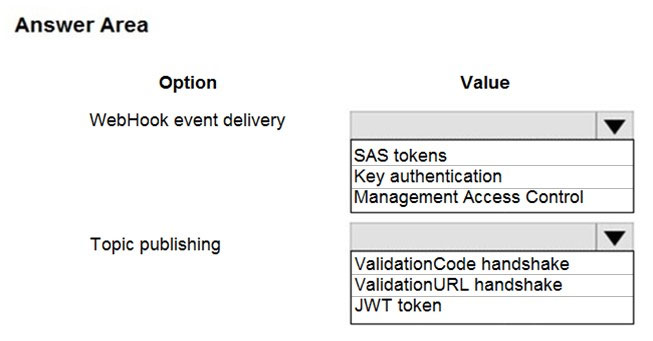
You are creating an app that uses Event Grid to connect with other services. Your app's event data will be sent to a serverless function that checks compliance.
This function is maintained by your company.
You write a new event subscription at the scope of your resource. The event must be invalidated after a specific period of time.
You need to configure Event Grid.
What should you do? To answer, select the appropriate options in the answer area.
NOTE: Each correct selection is worth one point.
Hot Area:

Question #250
HOTSPOT -
You are working for Contoso, Ltd.
You define an API Policy object by using the following XML markup:

For each of the following statements, select Yes if the statement is true. Otherwise, select No.
NOTE: Each correct selection is worth one point.
Hot Area:
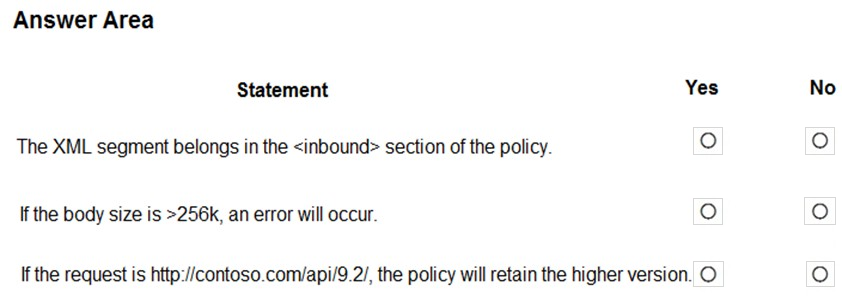
You are working for Contoso, Ltd.
You define an API Policy object by using the following XML markup:

For each of the following statements, select Yes if the statement is true. Otherwise, select No.
NOTE: Each correct selection is worth one point.
Hot Area:

Question #251
You are developing a solution that will use Azure messaging services.
You need to ensure that the solution uses a publish-subscribe model and eliminates the need for constant polling.
What are two possible ways to achieve the goal? Each correct answer presents a complete solution.
NOTE: Each correct selection is worth one point.
You need to ensure that the solution uses a publish-subscribe model and eliminates the need for constant polling.
What are two possible ways to achieve the goal? Each correct answer presents a complete solution.
NOTE: Each correct selection is worth one point.
Question #252
A company is implementing a publish-subscribe (Pub/Sub) messaging component by using Azure Service Bus. You are developing the first subscription application.
In the Azure portal you see that messages are being sent to the subscription for each topic. You create and initialize a subscription client object by supplying the correct details, but the subscription application is still not consuming the messages.
You need to ensure that the subscription client processes all messages.
Which code segment should you use?
In the Azure portal you see that messages are being sent to the subscription for each topic. You create and initialize a subscription client object by supplying the correct details, but the subscription application is still not consuming the messages.
You need to ensure that the subscription client processes all messages.
Which code segment should you use?
Question #254
Note: This question is part of a series of questions that present the same scenario. Each question in the series contains a unique solution that might meet the stated goals. Some question sets might have more than one correct solution, while others might not have a correct solution.
After you answer a question in this section, you will NOT be able to return to it. As a result, these questions will not appear in the review screen.
You are developing an Azure Service application that processes queue data when it receives a message from a mobile application. Messages may not be sent to the service consistently.
You have the following requirements:
✑ Queue size must not grow larger than 80 gigabytes (GB).
✑ Use first-in-first-out (FIFO) ordering of messages.
✑ Minimize Azure costs.
You need to implement the messaging solution.
Solution: Use the .Net API to add a message to an Azure Service Bus Queue from the mobile application. Create an Azure Windows VM that is triggered from
Azure Service Bus Queue.
Does the solution meet the goal?
After you answer a question in this section, you will NOT be able to return to it. As a result, these questions will not appear in the review screen.
You are developing an Azure Service application that processes queue data when it receives a message from a mobile application. Messages may not be sent to the service consistently.
You have the following requirements:
✑ Queue size must not grow larger than 80 gigabytes (GB).
✑ Use first-in-first-out (FIFO) ordering of messages.
✑ Minimize Azure costs.
You need to implement the messaging solution.
Solution: Use the .Net API to add a message to an Azure Service Bus Queue from the mobile application. Create an Azure Windows VM that is triggered from
Azure Service Bus Queue.
Does the solution meet the goal?
Question #255
DRAG DROP -
You are developing a REST web service. Customers will access the service by using an Azure API Management instance.
The web service does not correctly handle conflicts. Instead of returning an HTTP status code of 409, the service returns a status code of 500. The body of the status message contains only the word conflict.
You need to ensure that conflicts produce the correct response.
How should you complete the policy? To answer, drag the appropriate code segments to the correct locations. Each code segment may be used once, more than once, or not at all. You may need to drag the split bar between panes or scroll to view content.
NOTE: Each correct selection is worth one point.
Select and Place:
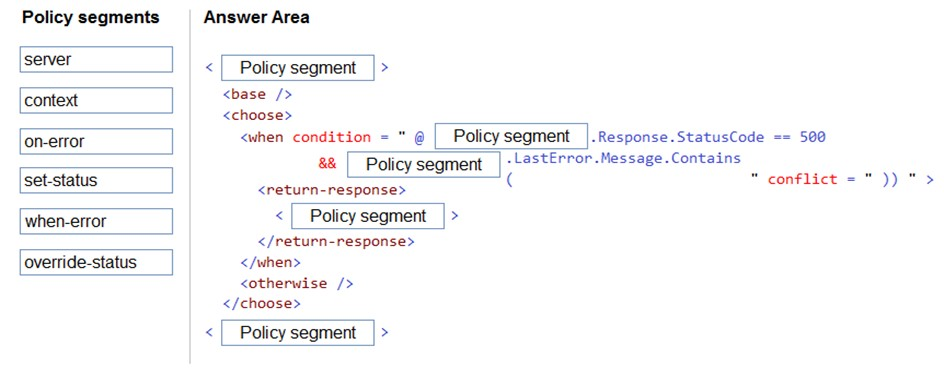
You are developing a REST web service. Customers will access the service by using an Azure API Management instance.
The web service does not correctly handle conflicts. Instead of returning an HTTP status code of 409, the service returns a status code of 500. The body of the status message contains only the word conflict.
You need to ensure that conflicts produce the correct response.
How should you complete the policy? To answer, drag the appropriate code segments to the correct locations. Each code segment may be used once, more than once, or not at all. You may need to drag the split bar between panes or scroll to view content.
NOTE: Each correct selection is worth one point.
Select and Place:

Question #256
DRAG DROP -
You are a developer for a Software as a Service (SaaS) company. You develop solutions that provide the ability to send notifications by using Azure Notification
Hubs.
You need to create sample code that customers can use as a reference for how to send raw notifications to Windows Push Notification Services (WNS) devices.
The sample code must not use external packages.
How should you complete the code segment? To answer, drag the appropriate code segments to the correct locations. Each code segment may be used once, more than once, or not at all. You may need to drag the split bar between panes or scroll to view content.
NOTE: Each correct selection is worth one point.
Select and Place:

You are a developer for a Software as a Service (SaaS) company. You develop solutions that provide the ability to send notifications by using Azure Notification
Hubs.
You need to create sample code that customers can use as a reference for how to send raw notifications to Windows Push Notification Services (WNS) devices.
The sample code must not use external packages.
How should you complete the code segment? To answer, drag the appropriate code segments to the correct locations. Each code segment may be used once, more than once, or not at all. You may need to drag the split bar between panes or scroll to view content.
NOTE: Each correct selection is worth one point.
Select and Place:

Question #257
Note: This question is part of a series of questions that present the same scenario. Each question in the series contains a unique solution that might meet the stated goals. Some question sets might have more than one correct solution, while others might not have a correct solution.
After you answer a question in this section, you will NOT be able to return to it. As a result, these questions will not appear in the review screen.
You are developing an Azure solution to collect point-of-sale (POS) device data from 2,000 stores located throughout the world. A single device can produce
2 megabytes (MB) of data every 24 hours. Each store location has one to five devices that send data.
You must store the device data in Azure Blob storage. Device data must be correlated based on a device identifier. Additional stores are expected to open in the future.
You need to implement a solution to receive the device data.
Solution: Provision an Azure Event Hub. Configure the machine identifier as the partition key and enable capture.
Does the solution meet the goal?
After you answer a question in this section, you will NOT be able to return to it. As a result, these questions will not appear in the review screen.
You are developing an Azure solution to collect point-of-sale (POS) device data from 2,000 stores located throughout the world. A single device can produce
2 megabytes (MB) of data every 24 hours. Each store location has one to five devices that send data.
You must store the device data in Azure Blob storage. Device data must be correlated based on a device identifier. Additional stores are expected to open in the future.
You need to implement a solution to receive the device data.
Solution: Provision an Azure Event Hub. Configure the machine identifier as the partition key and enable capture.
Does the solution meet the goal?
Question #258
DRAG DROP -
You are developing an Azure solution to collect inventory data from thousands of stores located around the world. Each store location will send the inventory data hourly to an Azure Blob storage account for processing.
The solution must meet the following requirements:
✑ Begin processing when data is saved to Azure Blob storage.
✑ Filter data based on store location information.
✑ Trigger an Azure Logic App to process the data for output to Azure Cosmos DB.
✑ Enable high availability and geographic distribution.
✑ Allow 24-hours for retries.
✑ Implement an exponential back off data processing.
You need to configure the solution.
What should you implement? To answer, select the appropriate options in the answer area.
NOTE: Each correct selection is worth one point.
Select and Place:

You are developing an Azure solution to collect inventory data from thousands of stores located around the world. Each store location will send the inventory data hourly to an Azure Blob storage account for processing.
The solution must meet the following requirements:
✑ Begin processing when data is saved to Azure Blob storage.
✑ Filter data based on store location information.
✑ Trigger an Azure Logic App to process the data for output to Azure Cosmos DB.
✑ Enable high availability and geographic distribution.
✑ Allow 24-hours for retries.
✑ Implement an exponential back off data processing.
You need to configure the solution.
What should you implement? To answer, select the appropriate options in the answer area.
NOTE: Each correct selection is worth one point.
Select and Place:

Question #259
You are creating an app that will use CosmosDB for data storage. The app will process batches of relational data.
You need to select an API for the app.
Which API should you use?
You need to select an API for the app.
Which API should you use?
Question #260
HOTSPOT -
You are developing a .NET application that communicates with Azure Storage.
A message must be stored when the application initializes.
You need to implement the message.
How should you complete the code segment? To answer, select the appropriate options in the answer area.
NOTE: Each correct selection is worth one point.
Hot Area:
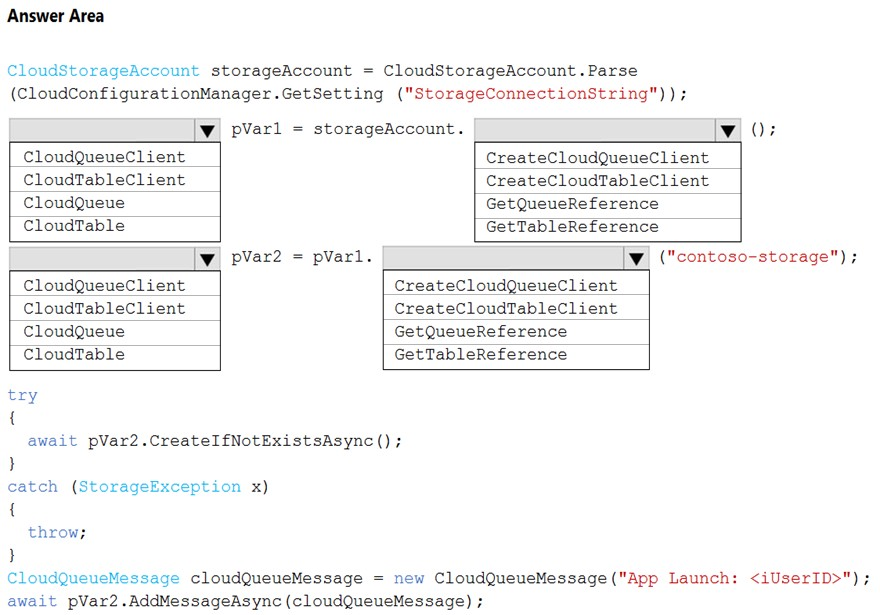
You are developing a .NET application that communicates with Azure Storage.
A message must be stored when the application initializes.
You need to implement the message.
How should you complete the code segment? To answer, select the appropriate options in the answer area.
NOTE: Each correct selection is worth one point.
Hot Area:

Question #261
HOTSPOT -
A software as a service (SaaS) company provides document management services. The company has a service that consists of several Azure web apps. All
Azure web apps run in an Azure App Service Plan named PrimaryASP.
You are developing a new web service by using a web app named ExcelParser. The web app contains a third-party library for processing Microsoft Excel files.
The license for the third-party library stipulates that you can only run a single instance of the library.
You need to configure the service.
How should you complete the script? To answer, select the appropriate options in the answer area.
NOTE: Each correct selection is worth one point.
Hot Area:
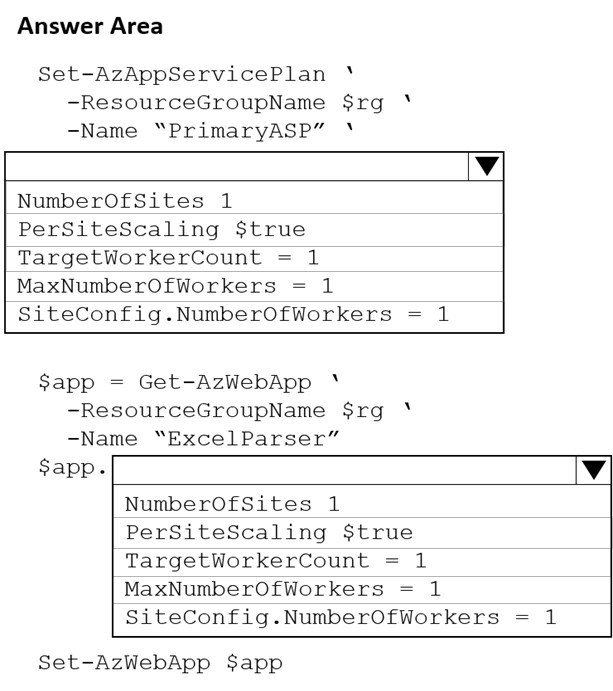
A software as a service (SaaS) company provides document management services. The company has a service that consists of several Azure web apps. All
Azure web apps run in an Azure App Service Plan named PrimaryASP.
You are developing a new web service by using a web app named ExcelParser. The web app contains a third-party library for processing Microsoft Excel files.
The license for the third-party library stipulates that you can only run a single instance of the library.
You need to configure the service.
How should you complete the script? To answer, select the appropriate options in the answer area.
NOTE: Each correct selection is worth one point.
Hot Area:

Question #262
DRAG DROP -
You have an application that provides weather forecasting data to external partners. You use Azure API Management to publish APIs.
You must change the behavior of the API to meet the following requirements:
✑ Support alternative input parameters
✑ Remove formatting text from responses
✑ Provide additional context to back-end services
Which types of policies should you implement? To answer, drag the policy types to the correct requirements. Each policy type may be used once, more than once, or not at all. You may need to drag the split bar between panes or scroll to view content.
NOTE: Each correct selection is worth one point.
Select and Place:

You have an application that provides weather forecasting data to external partners. You use Azure API Management to publish APIs.
You must change the behavior of the API to meet the following requirements:
✑ Support alternative input parameters
✑ Remove formatting text from responses
✑ Provide additional context to back-end services
Which types of policies should you implement? To answer, drag the policy types to the correct requirements. Each policy type may be used once, more than once, or not at all. You may need to drag the split bar between panes or scroll to view content.
NOTE: Each correct selection is worth one point.
Select and Place:

Question #263
You are developing an e-commerce solution that uses a microservice architecture.
You need to design a communication backplane for communicating transactional messages between various parts of the solution. Messages must be communicated in first-in-first-out (FIFO) order.
What should you use?
You need to design a communication backplane for communicating transactional messages between various parts of the solution. Messages must be communicated in first-in-first-out (FIFO) order.
What should you use?
Question #264
DRAG DROP -
A company backs up all manufacturing data to Azure Blob Storage. Admins move blobs from hot storage to archive tier storage every month.
You must automatically move blobs to Archive tier after they have not been modified within 180 days. The path for any item that is not archived must be placed in an existing queue. This operation must be performed automatically once a month. You set the value of TierAgeInDays to -180.
How should you configure the Logic App? To answer, drag the appropriate triggers or action blocks to the correct trigger or action slots. Each trigger or action block may be used once, more than once, or not at all. You may need to drag the split bar between panes or scroll to view content.
NOTE: Each correct selection is worth one point.
Select and Place:
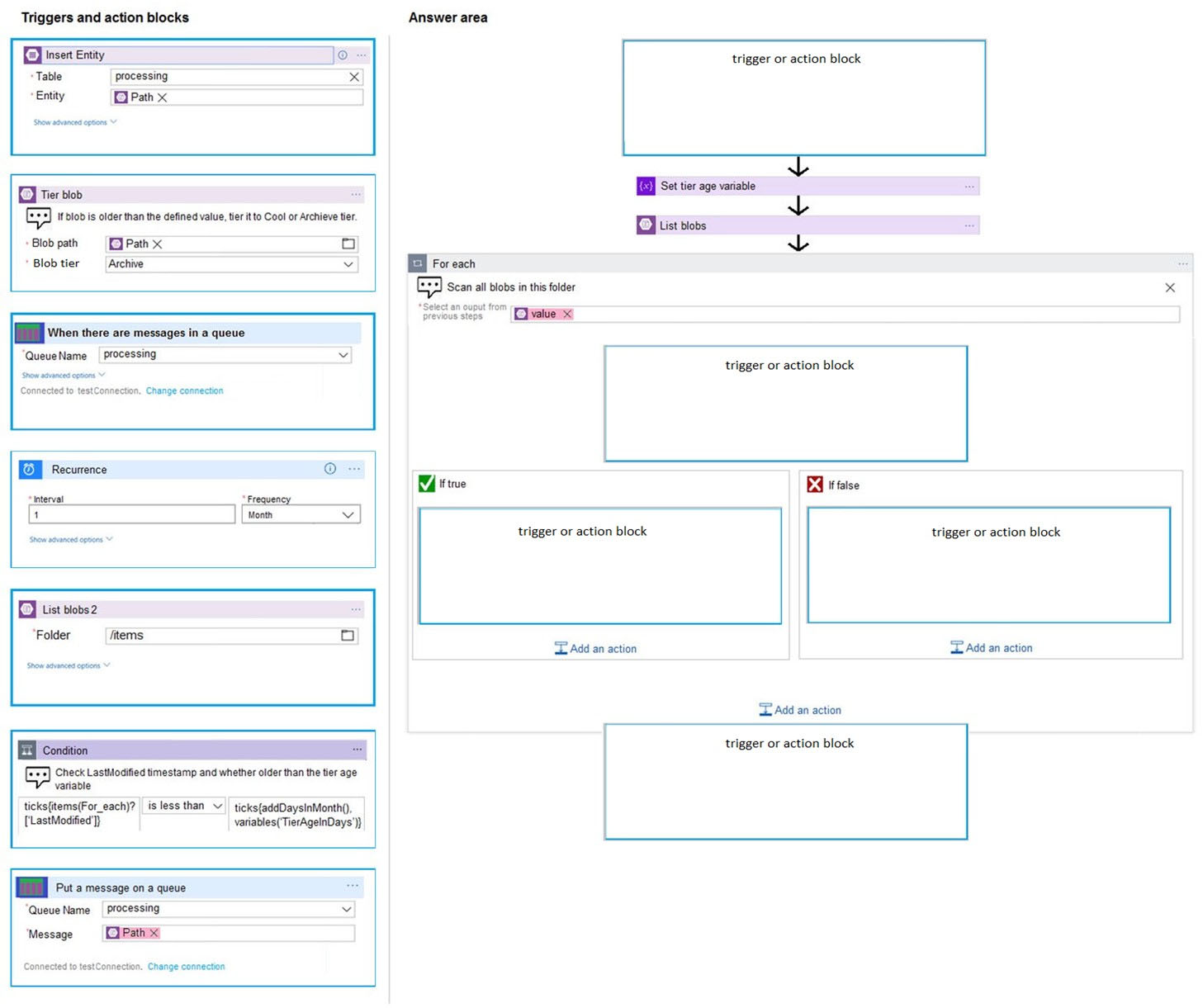
A company backs up all manufacturing data to Azure Blob Storage. Admins move blobs from hot storage to archive tier storage every month.
You must automatically move blobs to Archive tier after they have not been modified within 180 days. The path for any item that is not archived must be placed in an existing queue. This operation must be performed automatically once a month. You set the value of TierAgeInDays to -180.
How should you configure the Logic App? To answer, drag the appropriate triggers or action blocks to the correct trigger or action slots. Each trigger or action block may be used once, more than once, or not at all. You may need to drag the split bar between panes or scroll to view content.
NOTE: Each correct selection is worth one point.
Select and Place:

Question #265
Note: This question is part of a series of questions that present the same scenario. Each question in the series contains a unique solution that might meet the stated goals. Some question sets might have more than one correct solution, while others might not have a correct solution.
After you answer a question in this section, you will NOT be able to return to it. As a result, these questions will not appear in the review screen.
You are developing an Azure Service application that processes queue data when it receives a message from a mobile application. Messages may not be sent to the service consistently.
You have the following requirements:
✑ Queue size must not grow larger than 80 gigabytes (GB).
✑ Use first-in-first-out (FIFO) ordering of messages.
✑ Minimize Azure costs.
You need to implement the messaging solution.
Solution: Use the .Net API to add a message to an Azure Service Bus Queue from the mobile application. Create an Azure Function App that uses an Azure
Service Bus Queue trigger.
Does the solution meet the goal?
After you answer a question in this section, you will NOT be able to return to it. As a result, these questions will not appear in the review screen.
You are developing an Azure Service application that processes queue data when it receives a message from a mobile application. Messages may not be sent to the service consistently.
You have the following requirements:
✑ Queue size must not grow larger than 80 gigabytes (GB).
✑ Use first-in-first-out (FIFO) ordering of messages.
✑ Minimize Azure costs.
You need to implement the messaging solution.
Solution: Use the .Net API to add a message to an Azure Service Bus Queue from the mobile application. Create an Azure Function App that uses an Azure
Service Bus Queue trigger.
Does the solution meet the goal?
Question #266
Note: This question is part of a series of questions that present the same scenario. Each question in the series contains a unique solution that might meet the stated goals. Some question sets might have more than one correct solution, while others might not have a correct solution.
After you answer a question in this section, you will NOT be able to return to it. As a result, these questions will not appear in the review screen.
You are developing an Azure solution to collect point-of-sale (POS) device data from 2,000 stores located throughout the world. A single device can produce 2 megabytes (MB) of data every 24 hours. Each store location has one to five devices that send data.
You must store the device data in Azure Blob storage. Device data must be correlated based on a device identifier. Additional stores are expected to open in the future.
You need to implement a solution to receive the device data.
Solution: Provision an Azure Notification Hub. Register all devices with the hub.
Does the solution meet the goal?
After you answer a question in this section, you will NOT be able to return to it. As a result, these questions will not appear in the review screen.
You are developing an Azure solution to collect point-of-sale (POS) device data from 2,000 stores located throughout the world. A single device can produce 2 megabytes (MB) of data every 24 hours. Each store location has one to five devices that send data.
You must store the device data in Azure Blob storage. Device data must be correlated based on a device identifier. Additional stores are expected to open in the future.
You need to implement a solution to receive the device data.
Solution: Provision an Azure Notification Hub. Register all devices with the hub.
Does the solution meet the goal?
Question #267
You are building a loyalty program for a major snack producer. When customers buy a snack at any of 100 participating retailers the event is recorded in Azure
Event Hub. Each retailer is given a unique identifier that is used as the primary identifier for the loyalty program.
Retailers must be able to be added or removed at any time. Retailers must only be able to record sales for themselves.
You need to ensure that retailers can record sales.
What should you do?
Event Hub. Each retailer is given a unique identifier that is used as the primary identifier for the loyalty program.
Retailers must be able to be added or removed at any time. Retailers must only be able to record sales for themselves.
You need to ensure that retailers can record sales.
What should you do?
Question #268
DRAG DROP -
You develop and deploy a web app to Azure App Service in a production environment. You scale out the web app to four instances and configure a staging slot to support changes.
You must monitor the web app in the environment to include the following requirements:
✑ Increase web app availability by re-routing requests away from instances with error status codes and automatically replace instances if they remain in an error state after one hour.
✑ Send web server logs, application logs, standard output, and standard error messaging to an Azure Storage blob account.
You need to configure Azure App Service.
Which values should you use? To answer, drag the appropriate configuration value to the correct requirements. Each configuration value may be used once, more than once, or not at all. You may need to drag the split bar between panes or scroll to view content.
NOTE: Each correct selection is worth one point.
Select and Place:
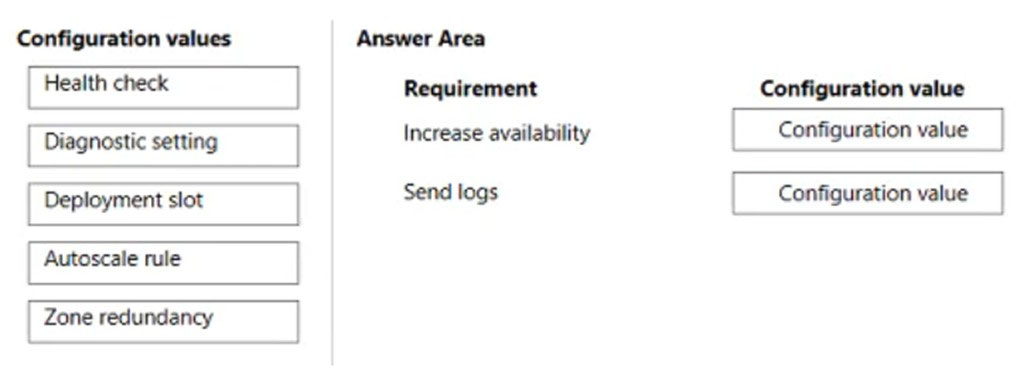
You develop and deploy a web app to Azure App Service in a production environment. You scale out the web app to four instances and configure a staging slot to support changes.
You must monitor the web app in the environment to include the following requirements:
✑ Increase web app availability by re-routing requests away from instances with error status codes and automatically replace instances if they remain in an error state after one hour.
✑ Send web server logs, application logs, standard output, and standard error messaging to an Azure Storage blob account.
You need to configure Azure App Service.
Which values should you use? To answer, drag the appropriate configuration value to the correct requirements. Each configuration value may be used once, more than once, or not at all. You may need to drag the split bar between panes or scroll to view content.
NOTE: Each correct selection is worth one point.
Select and Place:

Question #269
You develop a solution that uses Azure Virtual Machines (VMs).
The VMs contain code that must access resources in an Azure resource group. You grant the VM access to the resource group in Resource Manager.
You need to obtain an access token that uses the VM's system-assigned managed identity.
Which two actions should you perform? Each correct answer presents part of the solution.
The VMs contain code that must access resources in an Azure resource group. You grant the VM access to the resource group in Resource Manager.
You need to obtain an access token that uses the VM's system-assigned managed identity.
Which two actions should you perform? Each correct answer presents part of the solution.
Question #270
You are developing a road tollway tracking application that sends tracking events by using Azure Event Hubs using premium tier.
Each road must have a throttling policy uniquely assigned.
You need to configure the event hub to allow for per-road throttling.
What should you do?
Each road must have a throttling policy uniquely assigned.
You need to configure the event hub to allow for per-road throttling.
What should you do?

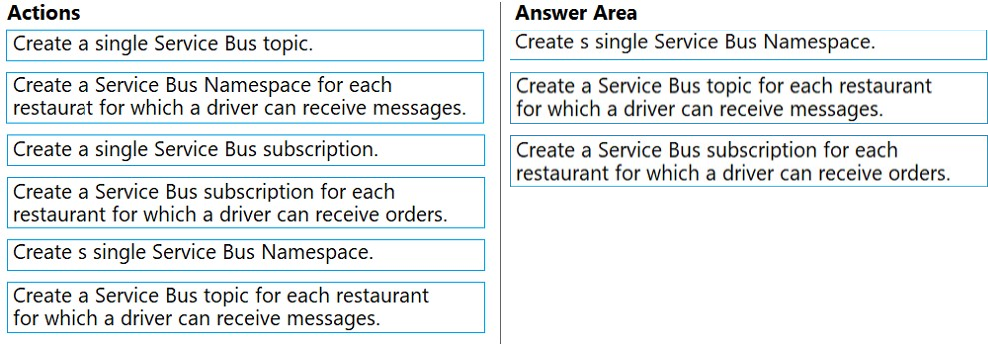
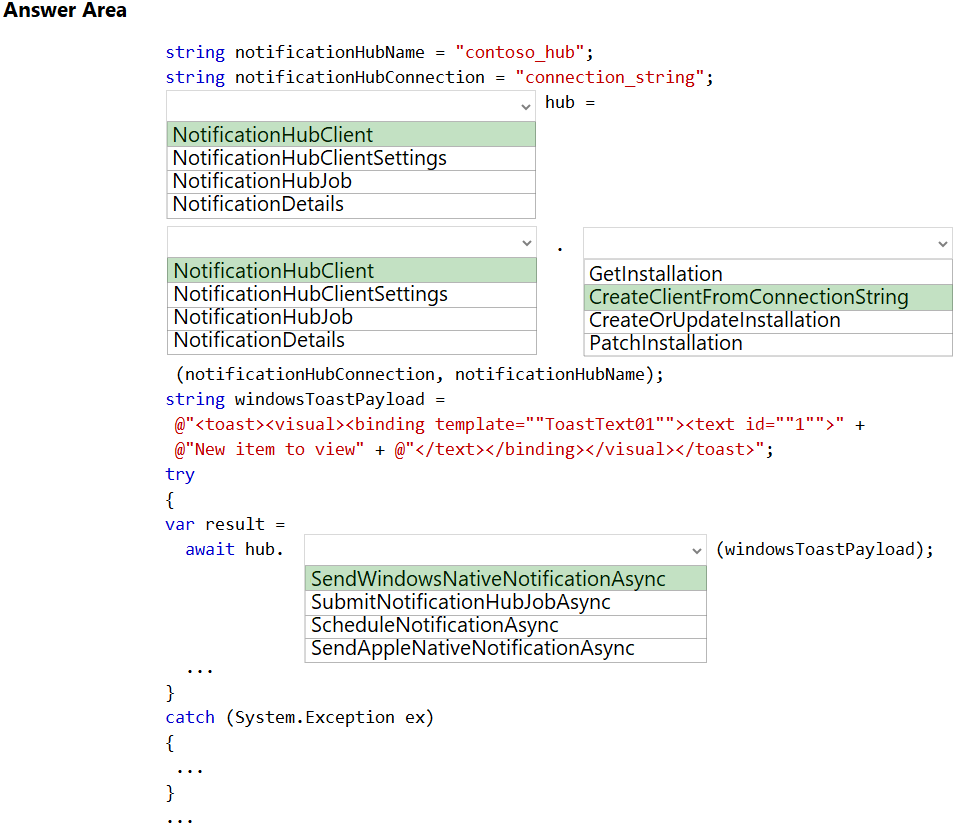
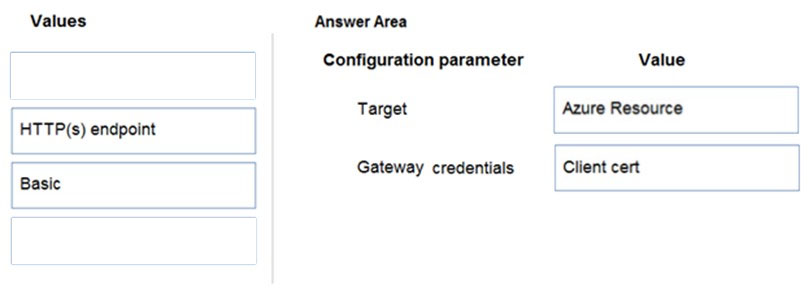
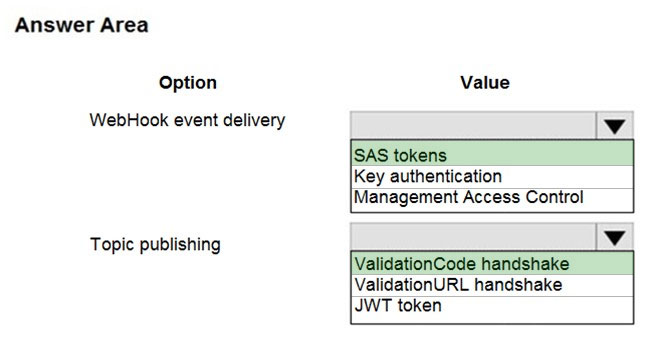
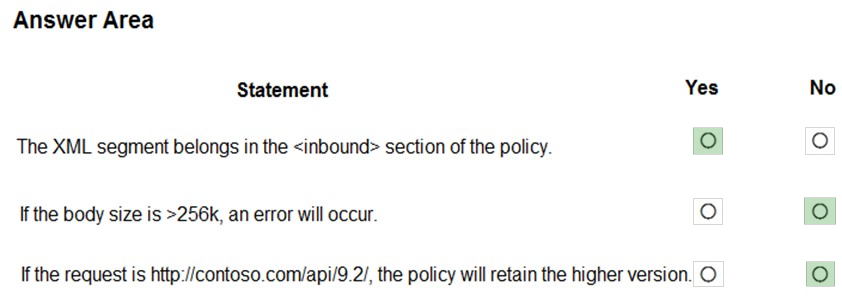
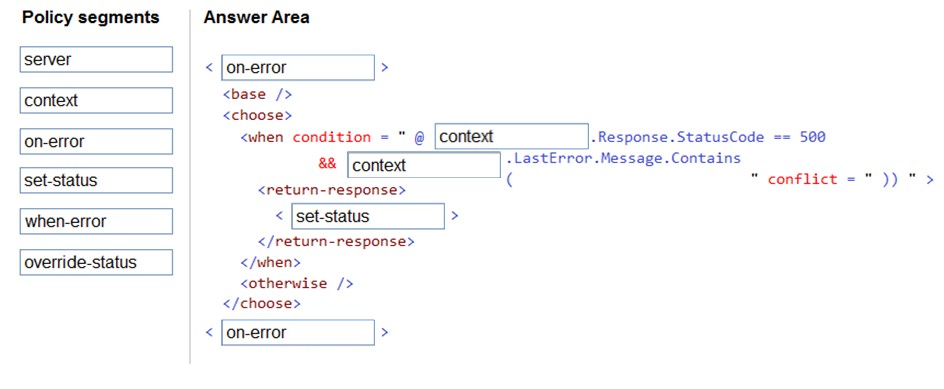


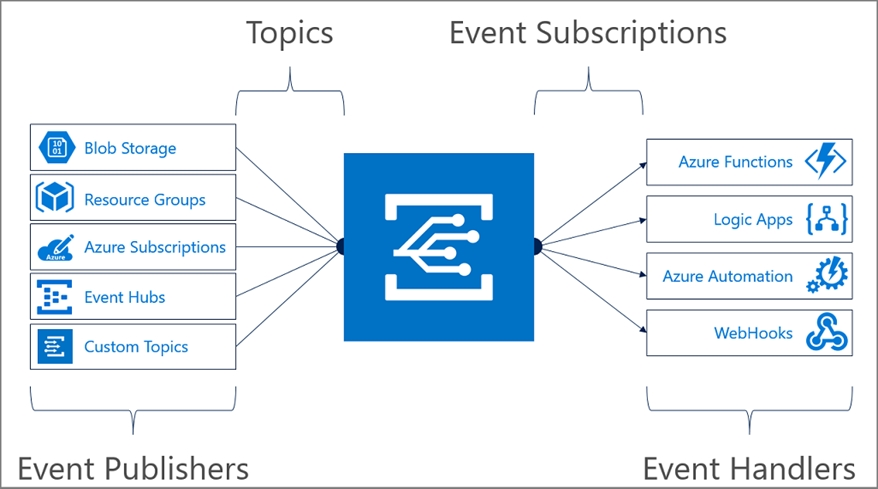
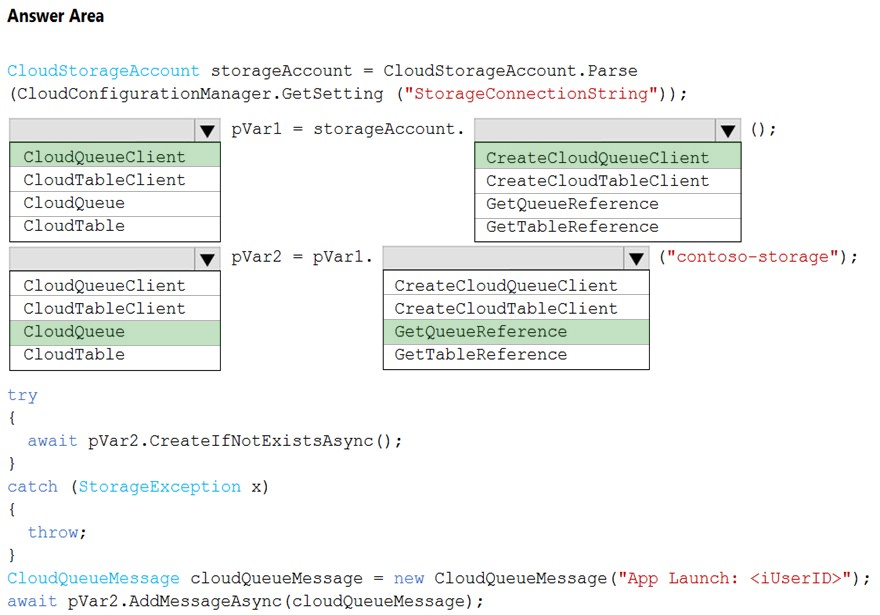
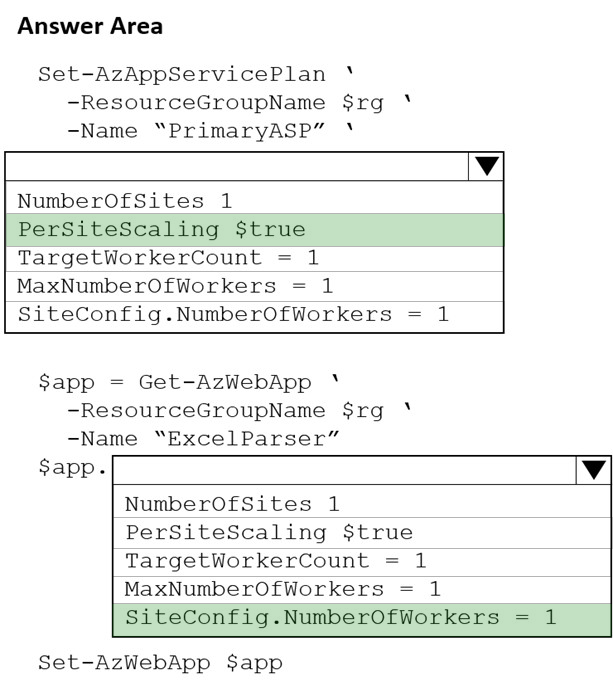
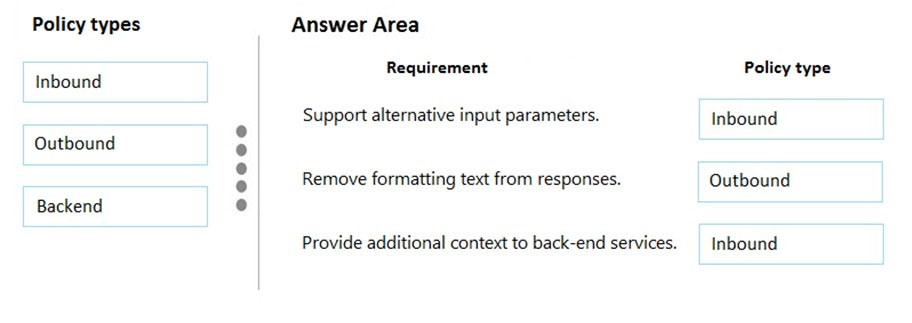
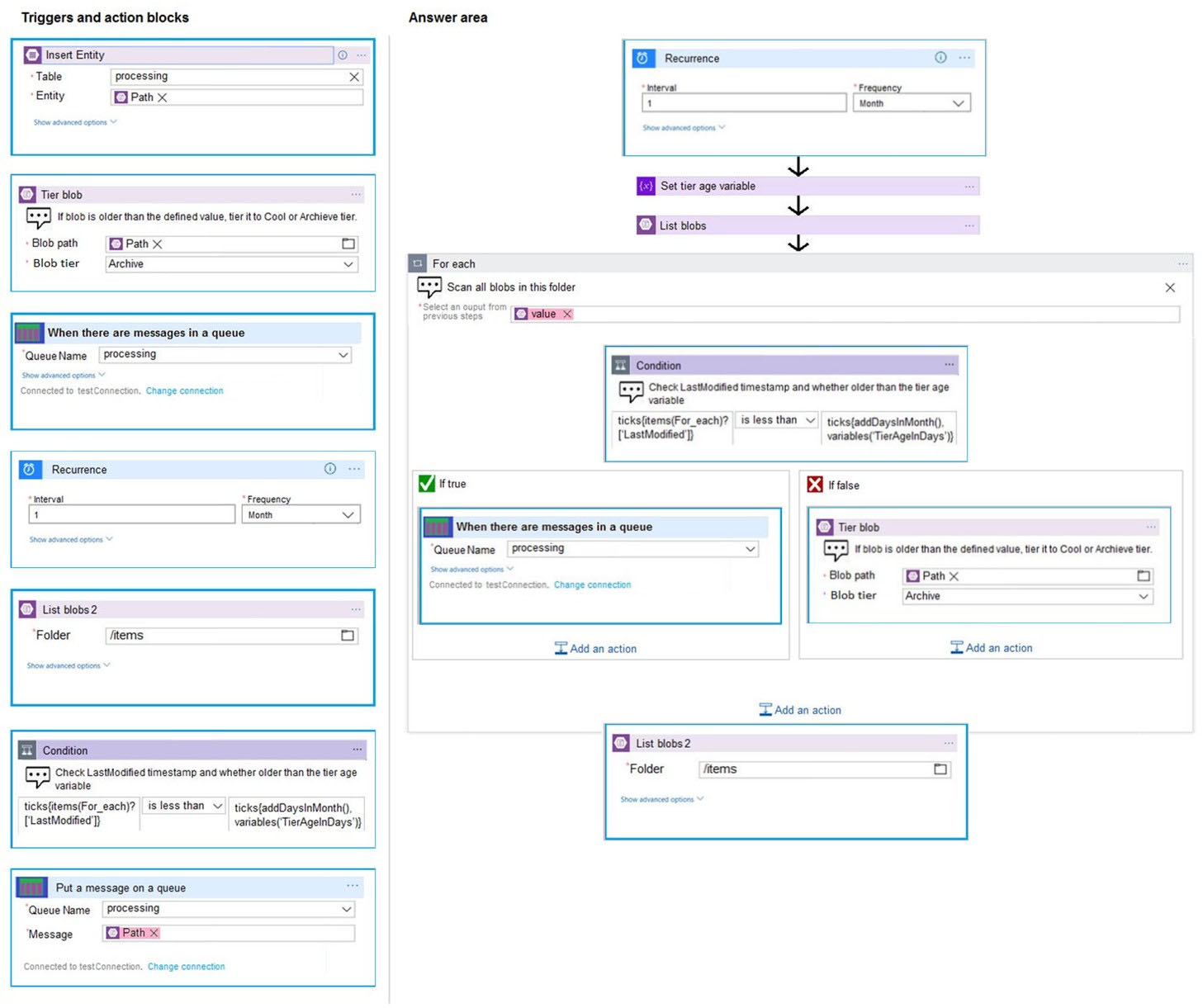
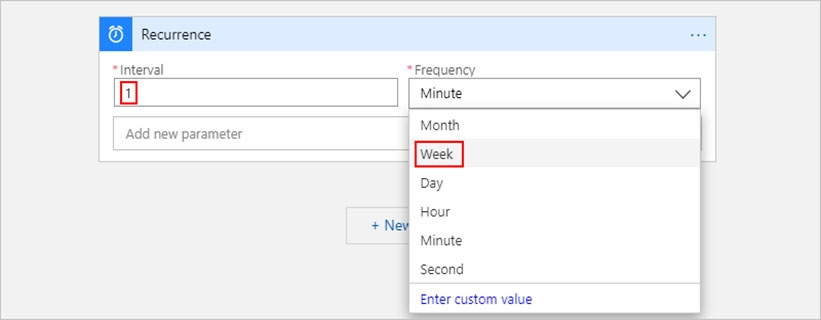
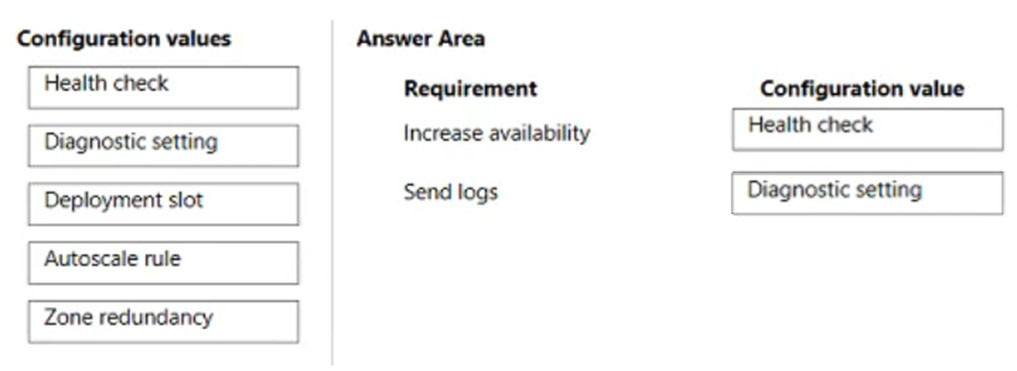
No comments:
Post a Comment